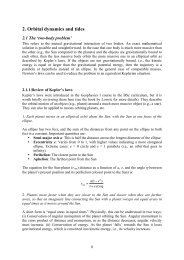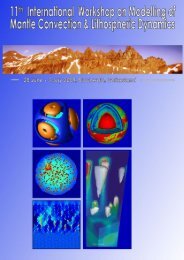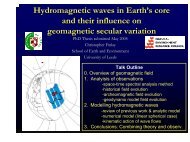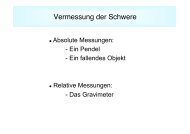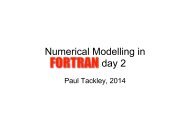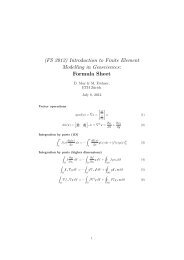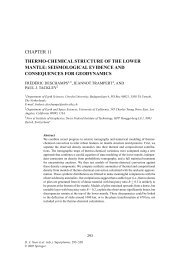Hydromagnetic waves in Earth's core and their influence on ...
Hydromagnetic waves in Earth's core and their influence on ...
Hydromagnetic waves in Earth's core and their influence on ...
You also want an ePaper? Increase the reach of your titles
YUMPU automatically turns print PDFs into web optimized ePapers that Google loves.
264 Appendix B — CALS7K.1B.6 Characteristics <str<strong>on</strong>g>and</str<strong>on</strong>g> evaluati<strong>on</strong> of the model CALS7K.1An RMS misfit of 1.00 was achieved for the model CALS7K.1 after data rejecti<strong>on</strong>, us<str<strong>on</strong>g>in</str<strong>on</strong>g>ga spatial damp<str<strong>on</strong>g>in</str<strong>on</strong>g>g parameter of 3 ×10 −7 nT −2 (spatial norm was 40 × 10 9 nT 2 ) <str<strong>on</strong>g>and</str<strong>on</strong>g> atemporal damp<str<strong>on</strong>g>in</str<strong>on</strong>g>g parameter of 5 × 10 −1 nT −2 yr 4 (temporal norm was 63×10 3 nT 2 yr −4 ).The best way of assess<str<strong>on</strong>g>in</str<strong>on</strong>g>g the success of a model is to compare its predicti<strong>on</strong>s to theorig<str<strong>on</strong>g>in</str<strong>on</strong>g>al data. This has been carried out by Korte <str<strong>on</strong>g>and</str<strong>on</strong>g> C<strong>on</strong>stable (2005) with lakesediment data <str<strong>on</strong>g>and</str<strong>on</strong>g> archeomagnetic data at a number of sites. In general the fit ofthe model to the data was found to be good, though there are some discrepancies, forexample <str<strong>on</strong>g>in</str<strong>on</strong>g> Lake Baikal <str<strong>on</strong>g>in</str<strong>on</strong>g> Japan where not even the trend was been well captured,suggest<str<strong>on</strong>g>in</str<strong>on</strong>g>g that this record may have some serious errors. The good fit of the modelto records <str<strong>on</strong>g>in</str<strong>on</strong>g> the Southern hemisphere was particularly encourag<str<strong>on</strong>g>in</str<strong>on</strong>g>g, given the sparsenature of data coverage there.B.7 Grid<str<strong>on</strong>g>in</str<strong>on</strong>g>g of CALS7K.1 for analysis <strong>on</strong> <str<strong>on</strong>g>core</str<strong>on</strong>g> surfaceIn order to carry out a space-time analysis of field features <str<strong>on</strong>g>in</str<strong>on</strong>g> CALS7K.1, the sphericalharm<strong>on</strong>ic field model for the magnetic potential V supplied by M<strong>on</strong>ika Korte (pers<strong>on</strong>alcommunicati<strong>on</strong> July 2004) was used al<strong>on</strong>g with equati<strong>on</strong>s (A.8)-(A.17) to evaluate B r<strong>on</strong> a regularly spaced grid <str<strong>on</strong>g>in</str<strong>on</strong>g> latitude, l<strong>on</strong>gitude <str<strong>on</strong>g>and</str<strong>on</strong>g> time at the <str<strong>on</strong>g>core</str<strong>on</strong>g> surface.In all cases a grid of spac<str<strong>on</strong>g>in</str<strong>on</strong>g>g 2 degrees <str<strong>on</strong>g>in</str<strong>on</strong>g> l<strong>on</strong>gitude by 2 degrees <str<strong>on</strong>g>in</str<strong>on</strong>g> latitude was used.This is c<strong>on</strong>siderably smaller then the resoluti<strong>on</strong> of a degree 10 spherical harm<strong>on</strong>ic model,ensur<str<strong>on</strong>g>in</str<strong>on</strong>g>g that no <str<strong>on</strong>g>in</str<strong>on</strong>g>formati<strong>on</strong> was lost through the grid<str<strong>on</strong>g>in</str<strong>on</strong>g>g procedure.For comparis<strong>on</strong> to gufm1 a subset of CALS7K.1 runn<str<strong>on</strong>g>in</str<strong>on</strong>g>g from 1600A.D to 1950A.D(called CALS7K.1h) was gridded with a temporal spac<str<strong>on</strong>g>in</str<strong>on</strong>g>g of 2 years. This is obviouslymuch higher than the temporal resoluti<strong>on</strong> <str<strong>on</strong>g>in</str<strong>on</strong>g> CALS7K.1, but facilitates straightforwardcomparis<strong>on</strong>s with the historical record. When study<str<strong>on</strong>g>in</str<strong>on</strong>g>g the full span of CALS7K.1 atemporal spac<str<strong>on</strong>g>in</str<strong>on</strong>g>g of 25 years was employed, aga<str<strong>on</strong>g>in</str<strong>on</strong>g> significantly less than the resoluti<strong>on</strong>of CALS7K.1. The study of the <str<strong>on</strong>g>in</str<strong>on</strong>g>terval from 2000B.C to 1700A.D. employs a 25 yeargrid spac<str<strong>on</strong>g>in</str<strong>on</strong>g>g.




